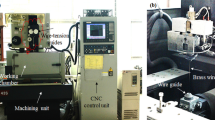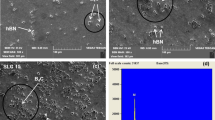Abstract
Complex profiles, comprising curved features and inclined surfaces, are an inherent attribute of tungsten carbide (WC-Co) tooling applications like dies, molds, and cutting tools. Such profiles are difficult to machine by conventional processes due to high hardness of WC-Co. Wire electric discharge machining (WEDM) is a frequently employed non-traditional machining process for producing intricate shapes and complex geometries in difficult-to-cut materials. However, this process offers its own challenges regarding machining accuracy of arced profiles such as undercutting or overcutting of material. Machining task becomes more complicated if arced profiles are to be machined at a certain taper angle. Keeping in view the stringent requirements of productivity and geometrical accuracy for WC-Co tooling, current research is focused on comprehensively evaluating the performance of WEDM process for producing complex tapered profiles in WC-Co composite. Furthermore, instead of using simple brass wire, a zinc-coated wire electrode is employed to enhance cutting rate. The impact of WEDM control variables namely, pulse-on/off time, servo voltage, and wire tension, in conjunction with workpiece taper, is studied on geometrical accuracy, cutting rate, and surface quality of complex tapered profile. Results of experimentation are analyzed using various statistical techniques. Scanning electron microscopy (SEM) and energy-dispersive X-ray (EDX) analysis are carried out for in-depth evaluation of machining results. Experimental results show that a complex tapered profile can be generated with as small as 0.16° angular error and 6-μm radial error using optimal parameter settings. Optimal settings of process parameters result into 33.3% reduction in angular error, 14.3% reduction in radial error, 12% increase in cutting speed, and 14.4% reduction in surface roughness of workpiece.









Similar content being viewed by others
References
Abdullah et al (2009) Effect of ultrasonic-assisted EDM on the surface integrity of cemented tungsten carbide (WC-Co). Int J Adv Manuf Technol 41:268–280
Jahan MP, Rahman M, Wong YS (2011) A review on the conventional and micro-electrodischarge machining of tungsten carbide. Int J Mach Tools Manuf 51(12):837–885
Firouzabadi HA, Parvizian J, Abdullah A (2015) Improving accuracy of curved corners in wire EDM successive cutting. Int J Adv Manuf Technol 76:447–459
Kumar A, Kumar V, Kumar J (2013) Multi-response optimization of process parameters based on response surface methodology for pure titanium using WEDM process. Int J Adv Manuf Technol 68:2645–2668
Shah A, Mufti NA, Rakwal D, Bamberg E (2011) Material removal rate, kerf, and surface roughness of tungsten carbide machined with wire electrical discharge machining. J Mater Eng Perform 20(1):71–76
Jangra K, Groover S, Chan FTS, Aggarwal A (2011) Digraph and matrix method to evaluate the machinability of tungsten carbide composite with wire EDM. Int J Adv Manuf Technol 56:959–974
Saha P, Singha A, Pal SK, Saha P (2008) Soft computing models based prediction of cutting speed and surface roughness in wire electro-discharge machining of tungsten carbide cobalt composite. Int J Adv Manuf Technol 39(1–2):74–84
Shayan AV, Afza RA, Teimouri R (2013) Parametric study along with selection of optimal solutions in dry wire cut machining of cemented tungsten carbide (WC-Co). J Manuf Process 15(4):644–658
Muthuraman V, Ramakrishnan R (2012) Multi parametric optimization of WC-Co composites using desirability approach. Procedia Eng 38:3381–3390
Jangra K, Grover S, Aggarwal A (2011) Digraph and matrix method for the performance evaluation of carbide compacting die manufactured by wire EDM. Int J Adv Manuf Technol 54:579–591
Jangra KK (2015) An experimental study for multi-pass cutting operation in wire electrical discharge machining of WC-5.3% Co composite. Int J Adv Manuf Technol 76:971–982
Jangra K, Groover S, Aggarwal A (2012) Optimization of multi machining characteristics in WEDM of WC-5.3%Co composite using integrated approach of Taguchi, GRA and entropy method. Front Mech Eng 7(3):288–299
Naveed R, Mufti NA, Mughal MP, Saleem MQ, Ahmed N (2017) Machining of curved profiles on tungsten carbide-cobalt composite using wire electric discharge process. Int J Adv Manuf Technol 93:1367–1378
Sanchez JA, de Lacalle LNL, Lamikiz A (2004) A computer-aided system for the optimization of the accuracy of the wire electro-discharge machining process. Int J Comp Integ Manuf 17(5):1413–1420
Sanchez et al. (2007) On the influence of cutting speed limitation on the accuracy of wire-EDM corner-cutting. J Mater Process Technol 182:574–579
Shichun et al. (2009) Analysis of kerf width in micro-WEDM. Int J Mach Tools Manuf 49:788–792
Sarkar S, Sekh M, Mitra S, Bhattacharyya B (2011) A novel method of determination of wire lag for enhanced profile accuracy in WEDM. Precision Engineering 35(2):339–347
Werner A (2016) Method for enhanced accuracy in machining curvilinear profiles on wire-cut electrical discharge machines. Precision Engineering 44:75–80
Conde A, Sanchez JA, Plaza S, Ramos JM (2016) On the influence of wire-lag on the WEDM of low-radius free-form geometries. Procedia CIRP 42(ISEM XVIII:274–279
Abyar H, Abdullah A, Akbarzadeh (2018) Analyzing wire defelection errors of WEDM process on small arced corners. J Manuf Processes 36:216–223
Selvakumar G, Jiju KB, Sarkar S, Mitra S (2016) Enhancing die corner accuracy through trim cut in WEDM. Int J Adv Manuf Technol 83:791–803
Abyar H, Abdullah A, Shafaroud AA (2019) Theoretical and experimental analysis of machining errors on small arced corners during WEDM finishing stages. Mach Sci Tecnol:1–24. https://doi.org/10.1080/10910344.2019.1575410
Sanchez JA, Plaza S, DeLacalle LN, Lamikiz A (2006) Computer simulation of wire-EDM taper-cutting. Int J Comput Integr Manuf 19:727–735
Nayak BB, Mahapatra SS (2014) A utility concept approach for multi-objective optimization of taper cutting operation using WEDM. Procedia Engineering 97:469–478
Antar MT, Soo SL, Aspinwall DK, Jones D, Perez R (2011) Productivity and workpiece surface integrity when WEDM aerospace alloys using coated wires. Procedia Eng 19:3–8
Klocke et al (2014) Evaluation of advanced wire-EDM capabilities for the manufacture of fir tree slots in inconel 718. In: Procedia CIRP14, pp 430–435
Rakwal et al (2009) Fabrication of compliant high aspect ratio silicon microelectrode arrays using micro-wire electrical discharge machining. Microsyst Technol 15(5):789–797
Chalisgaonkar R, Kumar J (2016) Investigation of the machining parameters and integrity of the work and wire surfaces after finish cut WEDM of commercially pure titanium. J Braz Soc Mech Sci Eng 38:883–911
Nourbakhsh F, Rajurkar KP, Malshe AP, Cao J (2013) Wire electro-discharge machining of titanium alloy. Procedia CIRP 5:13–18
Maher I, Sarhan AAD, Hamdi M (2014) Review of improvements in wire electrode properties for longer working time and utilization in wire EDM machining. Int J Adv Manuf Technol 76(1–4):329–351
Alafaghani A, Qattawi A (2018) Investigating the effect of fused deposition modeling processing parameters using Taguchi design of experiment method. J Manuf Processes 36:164–174
Mia M, Khan MA, Dhar NR (2017) Study of surface roughness and cutting forces using ANN, RSM, and ANOVA in turning of Ti-6Al-4V under cryogenic jets applied at flank and rake faces of coated WC tool. Int J Adv Manuf Technol 93:975–991
Plaza S, Ortega N, Sanchez JA, PomboI MA (2009) Original models for the prediction of angular error in wire-EDM taper-cutting. Int J Adv Manuf Technol 44:529–538
Sanchez JA, Plaza S, Ortega N, Marcos M, Albizuri J (2008) Experimental and numerical study of angular error in wire-EDM. Int J Mach Tools Manuf 48:1420–1428
Selvakumar G, Jiju KB, Veerajothi R (2016) Experimental study on wire electrical discharge machining of tapered parts. Arab J Sci Eng 41:4431–4439
Ishfaq K, Ahmed N, Mufti NA, Pervaiz S (2019) Exploring the contribution of unconventional parameters on spark gap formation and its minimization during WEDM of layered composite. Int J Adv Manuf Technol 102:1659–1669. https://doi.org/10.1007/s00170-019-03301-4
Ishfaq K, Mufti NA, Mughal MP, Saleem MQ, Ahmed N (2018) Investigation of wire electric discharge machining of stainless-clad steel for optimization of cutting speed. Int J Adv Manuf Technol 96:1429–1443
Rao PS, Ramji K, Satyanarayana B (2014) Experimental investigation and optimization of wire EDM parameters for surface roughness , MRR and white layer in machining of aluminum alloy. Procedia Mater Sci 5:2197–2206
Kuntoglu M, Saglam H (2019) Investigation of progressive tool wear for determining of optimized machining parameters in turning. Measurement 140:427–436
Acknowledgements
This research work is a part of PhD thesis titled “Optimization of process parameters for electric discharge machining of tungsten carbide tooling” submitted by Rakhshanda Naveed to University of Engineering and Technology Lahore-Pakistan.
Author information
Authors and Affiliations
Corresponding author
Additional information
Publisher’s note
Springer Nature remains neutral with regard to jurisdictional claims in published maps and institutional affiliations.
Rights and permissions
About this article
Cite this article
Naveed, R., Mufti, N.A., Ishfaq, K. et al. Complex taper profile machining of WC-Co composite using wire electric discharge process: analysis of geometrical accuracy, cutting rate, and surface quality. Int J Adv Manuf Technol 105, 411–423 (2019). https://doi.org/10.1007/s00170-019-04150-x
Received:
Accepted:
Published:
Issue Date:
DOI: https://doi.org/10.1007/s00170-019-04150-x




